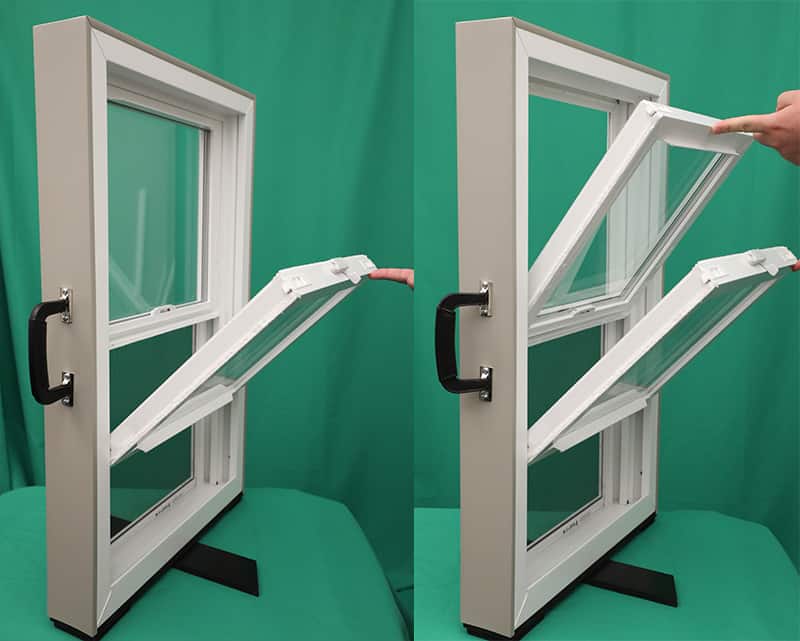Embarking on a window replacement project often brings a host of decisions, and one of the most common dilemmas homeowners face is choosing between seemingly similar window styles. Among the most traditional and frequently confused options are double-hung and single-hung windows. While they may look alike at first glance, there are distinct differences in their operation, benefits, and drawbacks. This post will clarify the key distinctions, pros, and cons of each, helping you decide which type is truly right for your home and your next window replacement.
Understanding Single-Hung Windows
Single-hung windows are a classic and widely used window style. Their defining characteristic is that only the bottom sash moves upward to open, while the top sash remains fixed and stationary.
Pros:
Cost-Effective:
Due to their simpler mechanics, single-hung windows are generally more affordable than their double-hung counterparts. This can be a significant advantage when budgeting for a large-scale window replacement.
Simplicity:
With fewer moving parts, there’s less potential for mechanical issues or wear and tear over time, potentially leading to lower long-term maintenance.
Good Seal:
The fixed top sash can contribute to a tighter seal when the window is closed, potentially offering decent energy efficiency by minimizing air infiltration.
Cons:
Limited Ventilation:
Since only the bottom half opens, single-hung windows provide less overall airflow compared to windows where both sashes operate.
Cleaning Challenges:
The exterior of the top fixed sash can be difficult to clean, especially for windows on upper floors or in hard-to-reach areas. You’ll likely need to clean it from the outside.
Less Versatile:
The limited opening options mean less flexibility in how you ventilate your home.
Understanding Double-Hung Windows
Double-hung windows take the traditional design a step further. In this style, both the top and bottom sashes can move independently – the bottom sash slides up, and the top sash slides down. A major benefit of modern double-hung windows is that both sashes often tilt inward, making cleaning much easier.
Pros:
Versatile Ventilation:
The ability to open both the top and bottom sashes simultaneously allows for more versatile airflow. You can open the top sash to let warm air escape and the bottom sash to draw in cooler air, promoting better convection and a more comfortable indoor environment.
Easy Cleaning:
This is often the most celebrated feature of double-hung windows. Both sashes typically tilt inward, allowing you to clean the exterior glass surfaces from inside your home, a huge convenience, especially for multi-story window replacement projects.
Aesthetics:
Double-hung windows offer a classic, balanced look that complements a wide variety of architectural styles, from historic homes to modern builds.
Safety:
The option to open only the top sash provides ventilation while keeping the bottom sash closed, which can be a safer choice for homes with small children or pets, preventing accidental falls.
Cons:
Higher Cost:
Due to their more complex mechanisms and added functionality, double-hung windows are generally more expensive than single-hung windows.
Potential for Air Leakage:
While modern designs have significantly improved, more moving parts and sash overlaps can sometimes lead to slightly less airtight seals compared to the simpler single-hung design. However, reputable manufacturers minimize this concern.
Maintenance:
More components mean a slightly higher potential for maintenance needs over time, though they are generally very durable.
Key Comparison Factors for Window Replacement
When deciding between these two popular options for your window replacement, consider these key factors:
Operation:
The fundamental difference lies in operation: a fixed top sash in single-hung versus a movable top sash in double-hung.
Ventilation:
Double-hung windows offer more versatile and effective airflow control.
Cleaning:
Double-hung windows with tilt-in sashes are significantly easier to clean from the inside.
Cost:
Single-hung windows are typically the more affordable upfront investment.
Energy Efficiency:
While both can be efficient, the quality of the seal and installation are paramount. Single-hung can have a slightly tighter fixed seal, but modern double-hungs are very competitive.
Aesthetics:
Both offer a traditional look, but double-hung provides more flexibility in how the window appears when open.
Safety:
The top-opening feature of double-hung windows provides an added layer of safety, particularly for families.
Which is Better for Your Home? (Decision Guide)
The “better” choice for your home ultimately depends on your specific needs, budget, and desired functionality for your window replacement.
Consider Your Priorities:
Budget:
If cost is a primary driver, single-hung windows often present a more economical option.
Cleaning Convenience:
If easy cleaning of exterior glass from inside your home is essential, double-hung windows are superior.
Ventilation Needs:
For maximum airflow control and the ability to vent warm air from the top while drawing in cool air from the bottom, double-hung is preferred.
Safety Concerns:
If you have children or pets and want to ventilate securely, double-hung windows offer more options.
Architectural Style:
Both fit many traditional and contemporary styles, but consider the specific look and how the opening mechanism will complement your home.
Specific Room Applications:
Basements/Utility Rooms:
Single-hung windows might suffice for basic needs where ventilation and cleaning are less critical.
Bedrooms/Living Areas:
Double-hung windows are often preferred in these living spaces for their superior ventilation and ease of cleaning.
Both single-hung and double-hung windows are excellent choices for a window replacement, each offering distinct advantages. Single-hung windows are a cost-effective and simple option with a good seal, while double-hung windows provide versatile ventilation, unparalleled ease of cleaning, and enhanced safety features.
Ultimately, the “better” choice for your home depends on your specific needs, budget, and desired functionality. We encourage you to evaluate your priorities, consult with experienced window professionals, and get quotes to make the best decision for your window replacement project that will enhance your home for years to come.







